Unit 3 Getting together Topic 1 第2课时 课件(仁爱科普版七年级上册)
文档属性
| 名称 | Unit 3 Getting together Topic 1 第2课时 课件(仁爱科普版七年级上册) | 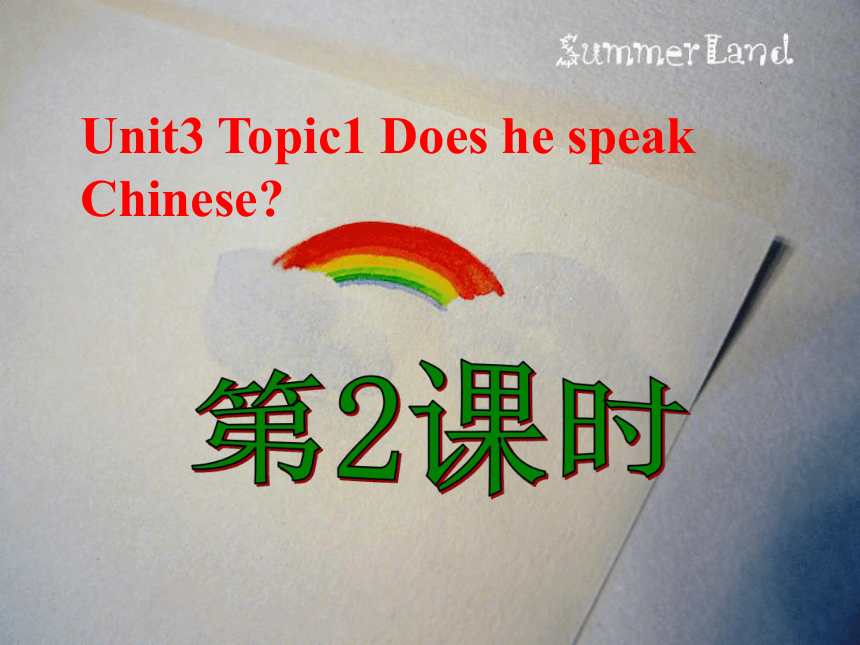 | |
| 格式 | ppt | ||
| 文件大小 | 1.6MB | ||
| 资源类型 | 试卷 | ||
| 版本资源 | 仁爱科普版 | ||
| 科目 | 英语 | ||
| 更新时间 | 2023-07-24 10:24:21 | ||
图片预览

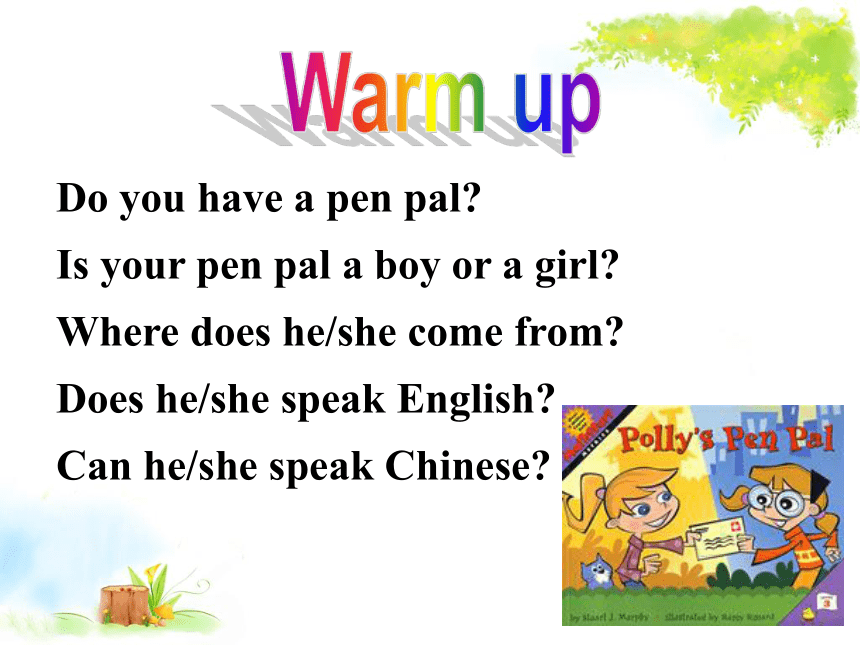
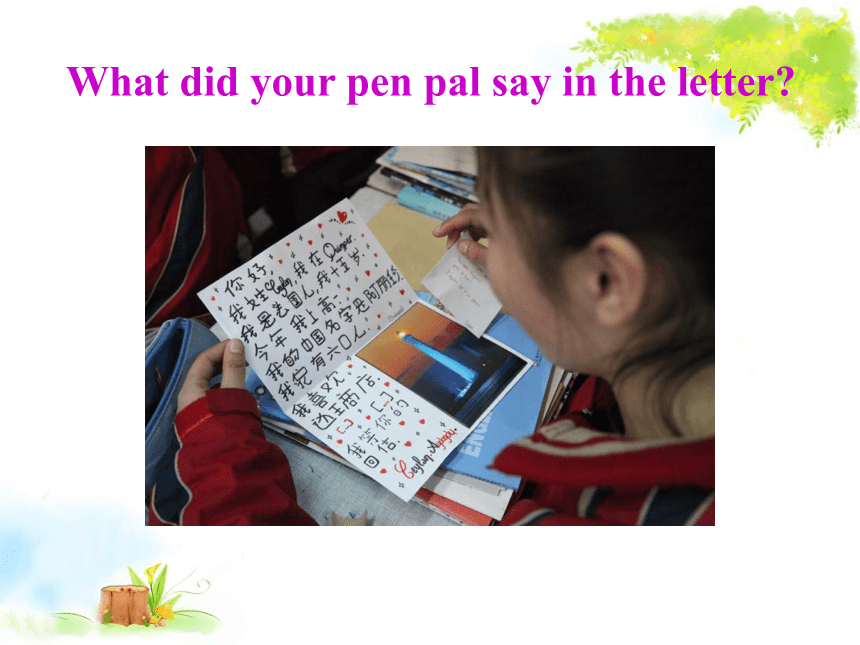
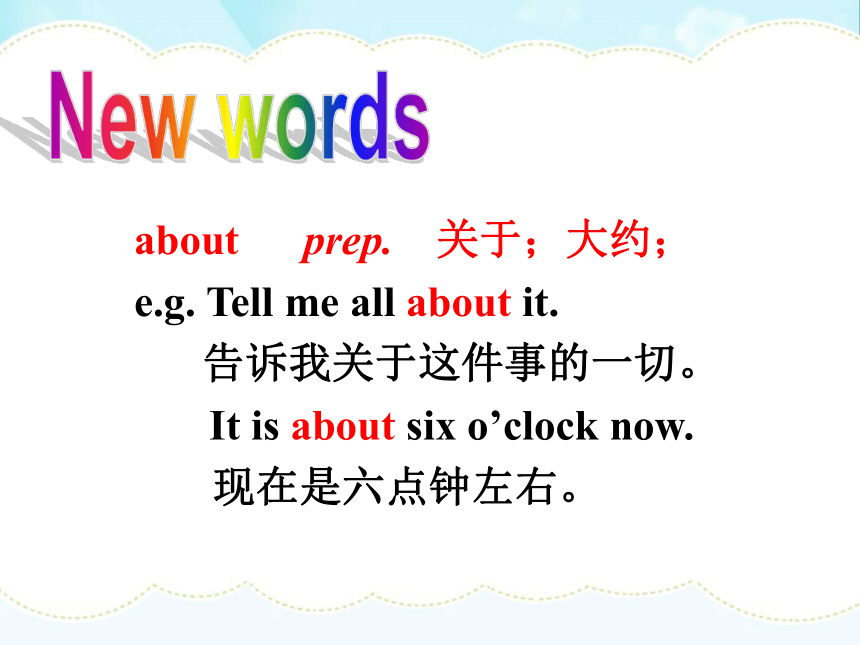
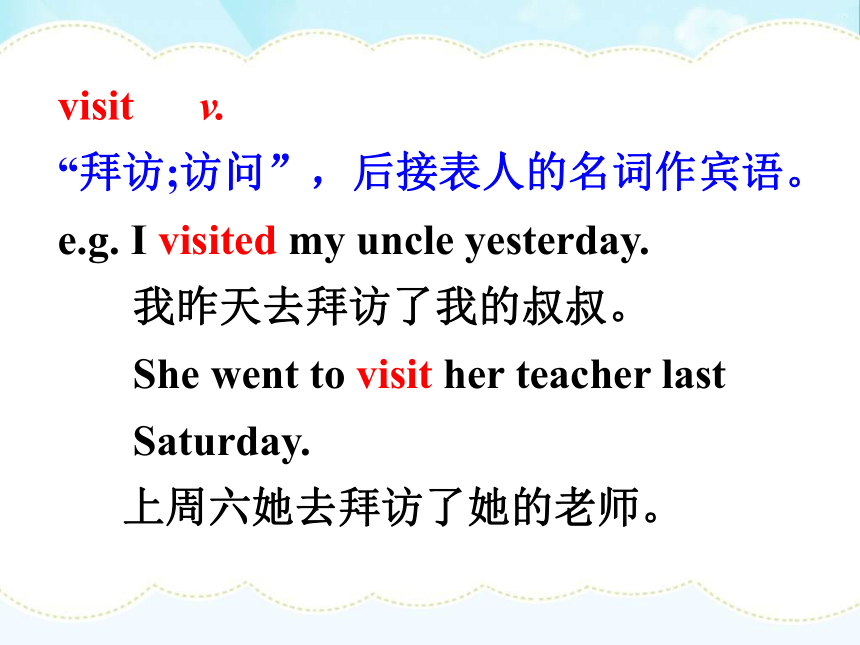


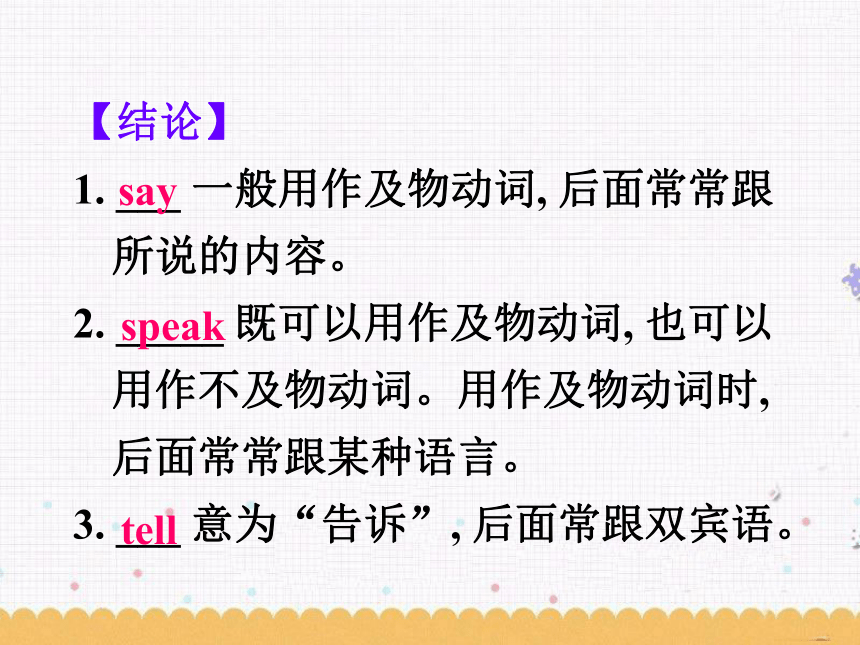

文档简介
(共29张PPT)
Unit3 Topic1 Does he speak Chinese
Do you have a pen pal
Is your pen pal a boy or a girl
Where does he/she come from
Does he/she speak English
Can he/she speak Chinese
What did your pen pal say in the letter
about prep. 关于;大约;
e.g. Tell me all about it. 告诉我关于这件事的一切。
It is about six o’clock now. 现在是六点钟左右。
visit v.
“拜访;访问”,后接表人的名词作宾语。
e.g. I visited my uncle yesterday.
我昨天去拜访了我的叔叔。
She went to visit her teacher last
Saturday.
上周六她去拜访了她的老师。
“参观;游览”, 后接表物的名词作宾语。
e.g. We are going to visit the Great Wall
next week.
我们下周将去游览长城。
1. say, speak与 tell都有“说”的意思, 但是它们的用法有所区别。观察下列例句,补全结论部分。
e.g.
Lucy’s mom says, “I like playing chess.”
You can’t speak in class.
He can speak Chinese.
Could you please tell me your name
【结论】
1. ___ 一般用作及物动词, 后面常常跟所说的内容。
2. _____ 既可以用作及物动词, 也可以用作不及物动词。用作及物动词时, 后面常常跟某种语言。
3. ___ 意为“告诉”, 后面常跟双宾语。
tell
say
speak
【提示】
1. 及物动词是指后面可以直接跟宾语的动词, 不及物动词是指后面不能直接跟宾语的动词。
2. 宾语多指动作的对象或承受者。
say, speak, tell
— Does he come from the U.S.A.
— No, he is Chinese, but he can
_____ English very well.
【运用】
请选出适当的词并用其适当的形式完成下列句子。
speak
2. Li Ming ____, “This is Mary’s coat.”
3. Please ___ me your pen pal’s name.
4. I want to ___ the good news (消息) to you.
tell
says
tell
2. live in + 地点 “居住在某地”
live with +人 “和某人一起生活”
e.g. I live in Beijing.
我住在北京。
He lives with his grandmother.
他和奶奶住在一起。
3. want “想, 想要”
want sth. “想要某物”
want to do sth. “想做某事”
want sb. to do sth. “想让某人做某事”
e.g. I want a white skirt.
He wants to go swimming.
Lucy wants me to go to the zoo with
her.
4. a lot of & a lot
观察下列例句,看看 a lot of和 a lot 在用法上有什么不同?然后补全结论部分所缺的内容。
e.g. There are a lot of books in our school
library.
We have a lot of time to make our plan.
I like Chinese action movies a lot.
【结论】
从例句1、2可知,a lot of可用来修饰可数名词复数或 ___________;由例句3可知,a lot可用来修饰_____。
不可数名词
动词
【运用】
下列各句中均有一处错误,请找出并改
正。
1. There is a lot milk in the glass.
_______________________________
2. Mother loves her children a lot of.
_______________________________
3. Jack has a lot of good habit.
_______________________________
There is a lot of milk in the glass.
Mother loves her children a lot.
Jack has a lot of good habits.
动词原形变第三人称单数的规则与发音规律同名词单数变复数大致相同, 请认真观察。
1) 大多数动词在词尾加“s”, 在清辅音后发音为[s], 在浊辅音及元音后发音为 [z]。
e.g.
① stop-stops [s] ; make-makes [s]
② read-reads [z] ; play-plays [z]
2) 以辅音字母加“y”结尾的, 要先将“y”变为“i”, 然后再加“es”, 读[iz]。
e.g.
fly-flies [z];
carry-carries [z]
study-studies [z];
worry-worries [z]
3) 以“s, x, ch, sh”结尾的, 在词尾加“es”, 发音为[iz]。
e.g. teach-teaches [iz];
watch-watches [iz]
4) 以“o”结尾的动词, 加“es”, 读[z]。
e.g. go-goes [z] do-does [z]
下面几个动词变为单数时, 原词的元音部分发音发生了较大的变化, 请注意。
e.g. do [du:]-does [d z] say [sei]-says [sez]
以不发音字母“e”结尾的开音节词, 如果尾音是[s], [z]时, 加“s”后, 字母“e”发音, 与所加“s” 一起读作[iz]。
e.g. close-closes [iz]
I. 请根据句意及所给汉语提示完成下列句子或对话(每空不限词数)。
1. Jack ____________ (想参观) our school.
2. He is a _____ (伟大的) man.
3. Kate ____ (居住) in Fuzhou now.
wants to visit
great
lives
4. — What does your mother ___ (说)
in the letter
— She wants to see me this Sunday.
5. Jim ______ (认识) the girl with brown short hair.
knows
say
II. 请写出下面动词的第三人称单数形式。
come ______ 2. meet _______
3. spell ______ 4. have _______
5. look ______ 6. like _______
7. think _______ 8. do _______
9. find _______ 10. give ______
gives
comes
meets
spells
has
looks
likes
thinks
does
finds
III. 请根据汉语意思完成下列英语句子, 每空一词。
1. 彼得能在英语方面帮助我。
Peter ___ ____ me ____ ___ English.
2. 我们经常在课后说英语。
We often _____ English ____ class.
can help
with my
speak
after
3. 这封信是谁寄来的? ____ __ the _____ from
4. 你住在美国吗? ___ you ___ __ the U.S.A.
live in
Who is
letter
Do
I
( )1. Do you have a sister
( )2. Where does Ann come from
( )3. Does Jim speak English
( )4. Can you help me with my English
( )5. Who’s the letter from
B
E
D
C
A
Ⅱ
A. It’s from my pen pal.
B. No, I don’t.
C. No problem.
D. Yes, he does.
E. She comes from Japan.
IV. 情景交际。
Imagine you have a pen pal in England, write a letter to him/her.
Unit3 Topic1 Does he speak Chinese
Do you have a pen pal
Is your pen pal a boy or a girl
Where does he/she come from
Does he/she speak English
Can he/she speak Chinese
What did your pen pal say in the letter
about prep. 关于;大约;
e.g. Tell me all about it. 告诉我关于这件事的一切。
It is about six o’clock now. 现在是六点钟左右。
visit v.
“拜访;访问”,后接表人的名词作宾语。
e.g. I visited my uncle yesterday.
我昨天去拜访了我的叔叔。
She went to visit her teacher last
Saturday.
上周六她去拜访了她的老师。
“参观;游览”, 后接表物的名词作宾语。
e.g. We are going to visit the Great Wall
next week.
我们下周将去游览长城。
1. say, speak与 tell都有“说”的意思, 但是它们的用法有所区别。观察下列例句,补全结论部分。
e.g.
Lucy’s mom says, “I like playing chess.”
You can’t speak in class.
He can speak Chinese.
Could you please tell me your name
【结论】
1. ___ 一般用作及物动词, 后面常常跟所说的内容。
2. _____ 既可以用作及物动词, 也可以用作不及物动词。用作及物动词时, 后面常常跟某种语言。
3. ___ 意为“告诉”, 后面常跟双宾语。
tell
say
speak
【提示】
1. 及物动词是指后面可以直接跟宾语的动词, 不及物动词是指后面不能直接跟宾语的动词。
2. 宾语多指动作的对象或承受者。
say, speak, tell
— Does he come from the U.S.A.
— No, he is Chinese, but he can
_____ English very well.
【运用】
请选出适当的词并用其适当的形式完成下列句子。
speak
2. Li Ming ____, “This is Mary’s coat.”
3. Please ___ me your pen pal’s name.
4. I want to ___ the good news (消息) to you.
tell
says
tell
2. live in + 地点 “居住在某地”
live with +人 “和某人一起生活”
e.g. I live in Beijing.
我住在北京。
He lives with his grandmother.
他和奶奶住在一起。
3. want “想, 想要”
want sth. “想要某物”
want to do sth. “想做某事”
want sb. to do sth. “想让某人做某事”
e.g. I want a white skirt.
He wants to go swimming.
Lucy wants me to go to the zoo with
her.
4. a lot of & a lot
观察下列例句,看看 a lot of和 a lot 在用法上有什么不同?然后补全结论部分所缺的内容。
e.g. There are a lot of books in our school
library.
We have a lot of time to make our plan.
I like Chinese action movies a lot.
【结论】
从例句1、2可知,a lot of可用来修饰可数名词复数或 ___________;由例句3可知,a lot可用来修饰_____。
不可数名词
动词
【运用】
下列各句中均有一处错误,请找出并改
正。
1. There is a lot milk in the glass.
_______________________________
2. Mother loves her children a lot of.
_______________________________
3. Jack has a lot of good habit.
_______________________________
There is a lot of milk in the glass.
Mother loves her children a lot.
Jack has a lot of good habits.
动词原形变第三人称单数的规则与发音规律同名词单数变复数大致相同, 请认真观察。
1) 大多数动词在词尾加“s”, 在清辅音后发音为[s], 在浊辅音及元音后发音为 [z]。
e.g.
① stop-stops [s] ; make-makes [s]
② read-reads [z] ; play-plays [z]
2) 以辅音字母加“y”结尾的, 要先将“y”变为“i”, 然后再加“es”, 读[iz]。
e.g.
fly-flies [z];
carry-carries [z]
study-studies [z];
worry-worries [z]
3) 以“s, x, ch, sh”结尾的, 在词尾加“es”, 发音为[iz]。
e.g. teach-teaches [iz];
watch-watches [iz]
4) 以“o”结尾的动词, 加“es”, 读[z]。
e.g. go-goes [z] do-does [z]
下面几个动词变为单数时, 原词的元音部分发音发生了较大的变化, 请注意。
e.g. do [du:]-does [d z] say [sei]-says [sez]
以不发音字母“e”结尾的开音节词, 如果尾音是[s], [z]时, 加“s”后, 字母“e”发音, 与所加“s” 一起读作[iz]。
e.g. close-closes [iz]
I. 请根据句意及所给汉语提示完成下列句子或对话(每空不限词数)。
1. Jack ____________ (想参观) our school.
2. He is a _____ (伟大的) man.
3. Kate ____ (居住) in Fuzhou now.
wants to visit
great
lives
4. — What does your mother ___ (说)
in the letter
— She wants to see me this Sunday.
5. Jim ______ (认识) the girl with brown short hair.
knows
say
II. 请写出下面动词的第三人称单数形式。
come ______ 2. meet _______
3. spell ______ 4. have _______
5. look ______ 6. like _______
7. think _______ 8. do _______
9. find _______ 10. give ______
gives
comes
meets
spells
has
looks
likes
thinks
does
finds
III. 请根据汉语意思完成下列英语句子, 每空一词。
1. 彼得能在英语方面帮助我。
Peter ___ ____ me ____ ___ English.
2. 我们经常在课后说英语。
We often _____ English ____ class.
can help
with my
speak
after
3. 这封信是谁寄来的? ____ __ the _____ from
4. 你住在美国吗? ___ you ___ __ the U.S.A.
live in
Who is
letter
Do
I
( )1. Do you have a sister
( )2. Where does Ann come from
( )3. Does Jim speak English
( )4. Can you help me with my English
( )5. Who’s the letter from
B
E
D
C
A
Ⅱ
A. It’s from my pen pal.
B. No, I don’t.
C. No problem.
D. Yes, he does.
E. She comes from Japan.
IV. 情景交际。
Imagine you have a pen pal in England, write a letter to him/her.
同课章节目录
- Unit 1 Making new friends
- Topic 1 Welcome to China!
- Topic 2 Where are you from?
- Topic 3 How old are you?
- Unit 2 Looking different
- Topic 1 I have a small nose
- Topic 2 What does she look like?
- Topic 3 Whose jacket is this?
- Unit 3 Getting togethe
- Topic 1 Does he speak Chinese?
- Topic 2 What do your parents do?
- Topic 3 What would you like to drink?
- Unit 4 Having fun
- Topic 1 What can I do for you?
- Topic 2 Would you like to cook with us?
- Topic 3 What time is it now?
